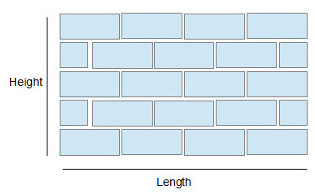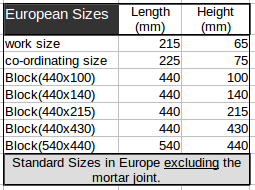The SI Bricks or Blocks in a Wall computes the number of bricks or blocks needed for a wall using the standard European brick and block sizes (see diagram). Masonry Brick or Block Wall
Masonry Brick or Block Wall Standard Unit Sizes For a count of brick or block in a wall using U.S. standard sizes, CLICK HERE.
Standard Unit Sizes For a count of brick or block in a wall using U.S. standard sizes, CLICK HERE.
INSTRUCTIONS: Choose units and enter the following:
- (l) Length of Wall
- (h) Height of Wall
- (mj) Mortar Joint thickness (Default is 10 mm)
- (bs) Brick or Block Size. Choose an European standard brick or block size via the pull-down menu.
- (M) Choose whether to add margin to the count estimate (See Note 1)
SI Bricks or Blocks in Wall (nB): The calculator return the number of brick or block required for the wall.
Note1: Choosing margin means that partial bricks or blocks that remain at the end of a row are discarded. Otherwise, the algorithm assumes all fractional bricks and blocks are used. The default is YES, because it is better to have a few too many bricks or blocks on the site than waist time waiting for more to come.
The Math / Science
The SI Bricks or Blocks in a Wall function calculates the number of brick or block needed for a wall based on the dimensions of the wall and the size of the brick or block. This calculation is for a block wall or brick fascia wall which implies that wall is one unit (brick or block) deep. The user identifies the height and length of the wall and chooses the brick or block from the pull down list. It then calculates the number of selected brick or block needed for the wall. The graphic shows a straight wall. However, the length can be provided for a circular or other-wised curved or serpentine wall, and the calculation should be accurate.
To do this, vCalc calculates the area of a wall and then uses the standard dimensions of bricks or blocks to determine how many bricks or blocks are needed for the construction of the wall. This is an ESTIMATION, and actual number of bricks or blocks needed may vary based on the thickness of the mortar joints and other factors. Nonetheless, this formula does take into account a nominal mortar joint. The ADD MARGIN option is a more conservative method. While one ideally would like to precisely pre-order and purchase the exact amount, it is better to have a small excess of materials that can be returned after the job, than to halt construction in order to acquire additional materials. This latter case is both frustrating and costly.
Brick and block unit sizes includes the most commonly used brick and block sizes in Europe. For a calculator that allows you to enter any brick or block size and a mortar joint, CLICK HERE.
Use
Brick and block walls are used in many applications, ancient to modern. They can be found in homes, building, and gardens. They can also be seen in general landscaping as retention walls.